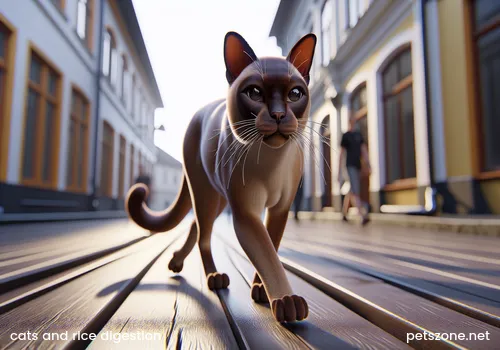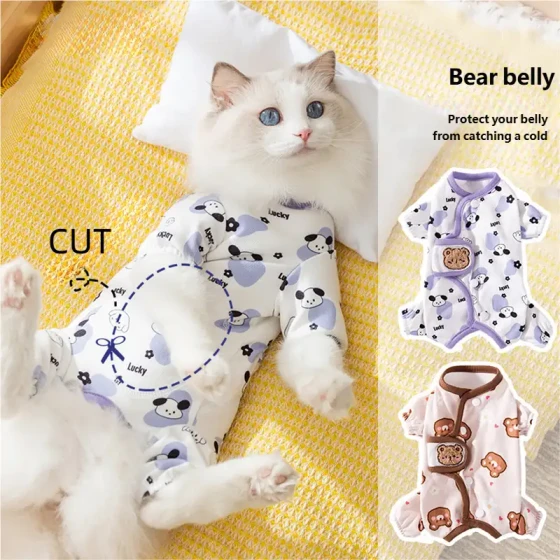Why Rural Cats Can Eat Rice Without Problem_The Secret of Cats Digesting Rice
Many people might wonder why, in rural areas, some cats seem to often eat rice and appear to have no major problems? Aren't cats carnivores? Can they really digest rice, a food high in carbohydrates? Don't worry, there are actually some interesting secrets behind the cat digestive system.

Cats: Born Carnivores
First, it must be clear that cats are strict carnivores, which means their body structure and metabolic mechanisms are mainly designed to digest and absorb animal proteins and fats. Their digestive tracts are relatively short, and their stomach acid is highly acidic—these traits help rapidly process meat.
The Challenge of Digesting Carbohydrates
So, for carbohydrate-rich foods like rice, cats really don’t digest them as easily as humans or dogs. This is mainly because cats lack sufficient digestive enzymes to effectively break down starch. For example, their saliva almost contains no amylase, which is the first step for us humans to digest starch. Although cats’ pancreas produces some amylase, the amount is much lower than in omnivorous animals like dogs. At the same time, enzyme activity for breaking down disaccharides in their small intestine is also low.
Therefore, if cats consume large amounts of carbohydrates, much of it may not get fully digested or absorbed; the undigested portion enters the large intestine, where gut bacteria ferment it, potentially causing bloating, diarrhea, vomiting, and other gastrointestinal discomfort symptoms.
The “No Problem” Mystery of Rural Cats Eating Rice
Given all this, why do rural cats seem lively and fine after eating rice? There may be several reasons here:
- Intake amount and frequency: Rural cats might not eat rice alongside large amounts of meat every meal; their main food sources are probably self-caught prey (such as mice, small birds) or small amounts of meat and kitchen scraps given by owners. Rice may only be a minor supplementary part of their diet, and the intake amount is not large. Small amounts of cooked white rice, especially soft porridge-like rice, are not completely indigestible for cats.
- Long-term adaptability (possible): Although cats are naturally not good at digesting large amounts of carbohydrates, if exposed from a young age and fed small amounts, their digestive systems might partially adapt, or their gut microbiota might change to help process these foods. However, this adaptability is limited, and long-term high-carb diets still carry health risks.
- The surface appearance of “no problem”: Seeing cats “fine” might just mean no acute or severe symptoms have appeared. Long-term intake of unsuitable foods can cause chronic health impacts, such as increased risks of obesity, diabetes, pancreatitis, etc. These problems may take time to manifest or have mild symptoms that are easily overlooked.
- Individual differences: Just like humans, cats have individual differences. Some cats may have relatively stronger digestive abilities and handle carbohydrates better.
The Benefits and Drawbacks of Rice for Cats
Although rice is not a necessary food for cats, cooked white rice occasionally fed in small amounts under specific circumstances is not entirely without benefits:
- Providing energy: Carbohydrates are an energy source; although cats are better at obtaining energy from proteins and fats, rice can still provide some energy.
- Helps digestion (limited): Cooked white rice, especially white rice, is relatively easy to digest. Occasional small intake with low fiber content is sometimes thought to help mild gastrointestinal discomfort (such as diarrhea), but this is not recommended by all veterinarians and is less effective than prescription diets formulated for cats. Brown rice, with higher fiber content, imposes a greater digestive burden on cats.
- Increasing satiety: As filler, rice can increase the volume of food and make cats feel fuller. However, this is not an ideal way of obtaining nutrition.
However, the potential drawbacks of rice for cats deserve more caution:
- Unbalanced nutrition: Rice cannot provide all essential nutrients cats require, such as taurine and high-quality animal protein. Long-term dependence on rice as the main food leads to malnutrition.
- Digestive burden: Cats’ limited ability to digest carbohydrates means excess intake can cause indigestion and gastrointestinal issues.
- Health risks: Long-term high carbohydrate intake may increase cats’ risk of obesity, diabetes, pancreatitis, and similar diseases.
- Affecting absorption of other nutrients: Studies show high-carb diets may impact cats’ absorption of protein.
- Raw rice danger: Uncooked rice contains natural harmful substances such as lectins, is hard to digest, and may cause vomiting and diarrhea in cats.
How to Feed Cats Scientifically
For domestic cats, the most scientific and healthy diet remains feeding commercial, nutritionally balanced cat food or canned food. These foods are scientifically formulated based on cats’ nutritional needs to provide all necessary nutrients. When selecting cat food, pay attention to products with high protein content and relatively low carbohydrate content.
If you want to improve your cat’s diet, you can occasionally feed some cooked, unseasoned chicken breast, fish, etc., but pay attention to quantity, and do not replace the main food. Always remember not to feed cats human leftovers, especially those containing oil, salt, or seasonings, as these are very harmful to cats’ health.
Frequently Asked Questions
Q: Can cats completely avoid carbohydrates in their diet?
A: Healthy adult cats have no absolute dietary requirement for carbohydrates. They can obtain needed energy and glucose from protein and fat.
Q: Is grain-free cat food the same as low-carb cat food?
A: Not necessarily. Grain-free cat food just means no grains but may use potatoes, peas, and other carbohydrate-rich ingredients instead. Therefore, grain-free does not equal low-carb. When choosing cat food, focus more on the carbohydrate content listed in ingredients.
Q: Can cats be fed rice when they have diarrhea?
A: Although some believe white rice helps cats with diarrhea, this is not the most recommended approach. It is best to consult a veterinarian and select prescription diets for gastrointestinal problems or follow professional advice.
Q: Why don’t cats like rice as much as dogs do?
A: Cats are obligate carnivores and have different food preferences than dogs. Cats are insensitive to sweetness, and rice’s main component is starch, which breaks down into sugars. They prefer the taste of animal protein and fat.
Summary
Rural cats eating rice seemingly without issues may relate to small intake amounts, individual differences, or unobserved potential chronic health problems. From the perspective of cats’ physiology and nutritional needs, rice is not their ideal food. As responsible "pet parents," we should strive to provide cats with a balanced diet aligned with their carnivorous nature. Commercial cat food or homemade healthy cat meals are better choices, allowing our furry friends to live healthier and longer lives.
-560x560.webp)

-560x560.webp)


